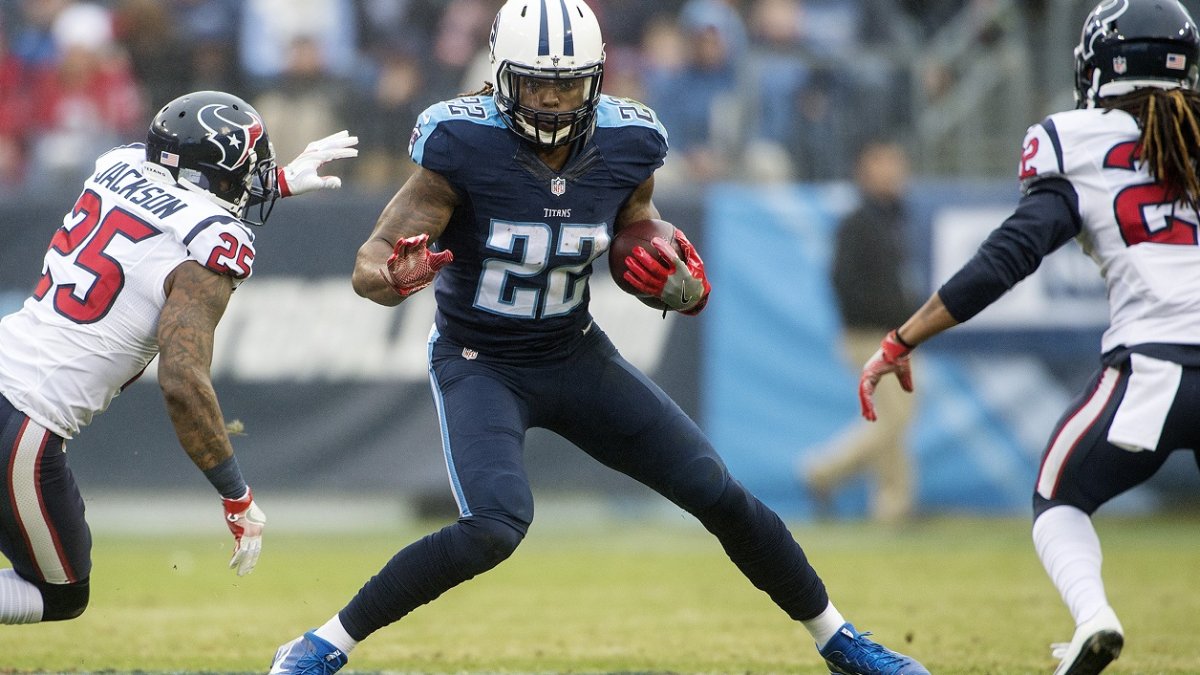(“Today’s Crazy Fantasy Stat” is an occasional offseason offering from PFF that highlights something that catches our eye and aids in our preparation for the 2017 fantasy season.)
In 2014, Carolina Panthers running back Jonathan Stewart caught 25 passes and, on those receptions, forced 16 missed tackles. That is one missed tackle every 0.64 receptions, and it’s the second-highest rate for a running back in the PFF era (since 2006).
The highest rate? That happened in 2016, when Tennessee Titans rookie Derrick Henry caught 13 passes … and forced 12 missed tackles on those receptions. That’s a rate of 0.92.
To review, the best of the PFF era is 0.92, and the second-best is 0.64, followed by 0.62, then a bunch of guys in the 0.50-0.59 range, and so on. On an admittedly small sample size, Henry forced missed tackles after the catch at a far better rate than any running back PFF has ever tracked.
Henry isn’t a pass-catching back, in usage or in prototypical size. Darren Sproles is listed at 5-foot-6, 190 pounds. Danny Woodhead is 5-8, 200. Duke Johnson is 5-9, 210. Henry? Henry is listed at 6-3 and 247 pounds, far more LeGarrette Blount than Dion Lewis. In his last two years of college at Alabama, Henry had 15 total receptions (against 568 rushes). And then there’s this: Henry had five receptions in 2014 … and forced five missed tackles. He had 10 in 2015 … and forced 10.
In fun with small samples, Henry had those 12 forced missed tackles on receptions on 13 receptions. The next fewest receptions for any back with 12-plus forced missed tackles belonged to that Stewart season in 2014. The average number of receptions for backs who have forced 12 or more missed tackles after the catch is 53.2.
Henry famously was the Smee to DeMarco Murray’s Captain Hook in 2016. Murray had 293 carries against Henry’s 110, with both averaging roughly the same yards per carry (4.39 for Murray, 4.45 for Henry). In slightly less than triple the carries, Murray had slightly more than triple the forced missed tackles on those carries (46 to Henry’s 15). Henry had more yards after contact per carry (2.6 to Murray’s 2.4), but those were close as well.
But on receptions, Murray — whose 53 receptions were more than quadruple Henry’s 13 — forced only four missed tackles, a third of Henry’s number. Murray had 377 receiving yards on his 53 receptions (7.1 yards per reception), while Henry had 137 on his 13 (10.5 yards per reception). The scales are wildly different, but those were two backs who put up basically the same rushing efficiency numbers in 2016, but had drastically different levels of success through the air.
None of this is to say Derrick Henry is around to be the third-down/pass-catching back in the Tennessee offense. He's a mauler, there to run the ball down throats. The point is that on the ground, he does a lot of what Murray does, and in the air (with the continued small-sample caveat), he's looked slightly better. That all helps explain why Henry had the No. 7 elusive rating (PFF’s measure that boils down a runner’s success beyond the help he gets from his blockers) last year, while Murray’s was 30th-best, tied with Jerick McKinnon.
Heading into 2017, Murray is the No. 8 running back off the board (14th overall), according to Fantasy Football Calculator. Henry is the No. 31 RB, 71st overall. I noted recently that Henry (at the time) was being drafted like a borderline starter. He’s slipped a bit since then, but he’s still going as one of the top backs who doesn’t have a clear line to his team’s No. 1 gig (the Falcons and Saints are the only teams to have two running backs currently higher in ADP than Henry). And barring injury to Murray, that seems about right for Henry, who will still cede a lot of work to the veteran Murray.
But Murray’s ADP. As it stands, he’s going ahead of names like Jordan Howard and Todd Gurley. In Murray’s defense, his offensive line is among the league’s elite, and that will keep any running back relevant. But Howard and Gurley have no real contender to steal their work, while the just-as-efficient Henry is barking at Murray’s heels, and he’s doing it at 23 compared to the 29-year-old Murray.
To me, Murray profiles as a mid-to-high RB2 in 2017, but he’s being drafted as a mid-to-low RB1. Pay attention to the efficiency numbers Henry put up in 2016 and mark Murray down just a bit.




 © 2025 PFF - all rights reserved.
© 2025 PFF - all rights reserved.